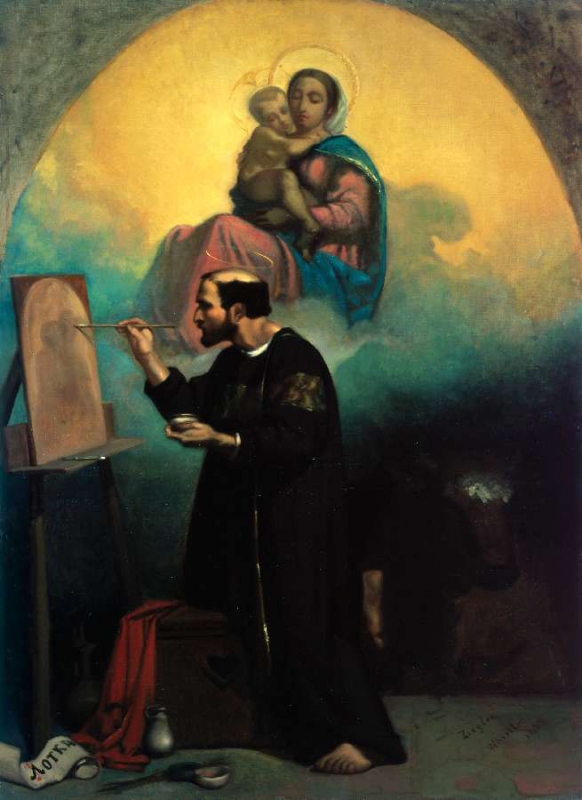Home > Catalogue > Browse > Copy after Ziegler's 'La Vision de St Luc' << >>
Composition
Whistler copied the painting by Ziegler closely, as Robertson states, 'Whistler’s copy is in all respects, bar the omission of a group of attendant putti in the clouds at right and the simplification of the floor tiling, a faithful representation of the original at approximately one third of its scale.' 1 However, the colour range has been somewhat changed, with the grey clouds shifted towards blue and the pale cream sky to a darker yellow.
The original painting by Ziegler is in the Musée des Beaux-Arts, Dunkirk, a sketch is in the MUDO (Musée de l’Oise, Beauvais), and a non-autograph copy is in the Musée Magnin in Dijon. 2
Technique
There is a thin white priming present, likely lead white in oil, applied to a glue-sized canvas. The spandrels are curved, and there are have some paint brushstrokes or more likely unpigmented medium on them.
There may be a very thin buff imprimatura, or else Whistler may have established the composition with a pale wash of colour (there is no trace of under-drawing). The paint is very thin, and pigments include vermilion, possibly chrome orange, synthetic ultramarine and coarse bone black, mixed into lead white. These are all colours that Whistler would use regularly in later life. The surface is worked from dark to light, the darks thinly applied and revealing the canvas weave, the lights applied thickly or with light impasto. 3
It is painted very carefully, imitating the restrained brushwork of the original. Many of the outlines are soft-edged and carefully shaded, but there are some crisp outlines, for instance on the drapery to left of the jug.
Major W. L. B. Jenney, whom Eddy described as a fellow-student of Whistler's in Paris, mentions an incident when Whistler was copying a painting – possibly this one:
'One day, in the Luxembourg, Whistler had his easel in a crowd with the others. They were all at work making copies from a famous picture that had just been added to the gallery. Whistler would paint a bit, and then rush back to contemplate what he had done. In one of these mad backward rushes he struck a step-ladder on the top of which was a painter', and this brought down several painters and their canvases in a great heap.' 4
Whistler thought his copies for Captain Williams were 'wonderful things.' 5
Conservation History
The colour is considerably darker than in the original, and it may be that the paint and varnish has darkened.
Frame
Wooden frame with arched top.
Notes:
1: P. Robertson 2010 [more], at pp. 13-14.
2: Joconde, Portail des collections des musées de France, catalogue entry in database at http://www.culture.gouv.fr.
3: Report by Professor Joyce H. Townsend, Tate, July 2017, GU WPP.
4: Jenney 1898 [more]; Eddy 1903 [more], p. 87. The guard was going to throw Whistler out, but the painters explained it was an accident and he was let off.
Last updated: 25th November 2020 by Margaret







